The Ultimate Guide to Recycling K-Cups, Nespresso Capsules, and Other Coffee Pods
With a little effort, you can make your coffee habit greener
When you shop through retailer links on our site, we may earn affiliate commissions. 100% of the fees we collect are used to support our nonprofit mission. Learn more.
Single-use coffee pods and capsules are more popular than ever. In 2023, according to the National Coffee Association and Statista, a market research firm, 27 percent of U.S. coffee drinkers used a single-serve coffee machine to prepare their coffee on a given day. If we do some rough math based on the 63 percent of daily American coffee drinkers, that means that somewhere between 50 and 60 million used coffee pods are thrown out or recycled every day.
While many coffee pods are now recyclable, including all Keurig K-Cups as of late 2020, it’s unclear whether people are following through with recycling. That’s because, compared with tossing an empty soda can in the recycling bin, there’s a bit of extra effort involved for coffee pods.
Some pod brands have recycling programs, which is great, but it means you need to collect and mail your pods to them. For other pods, you can toss them into recycling bins yourself, but you first need to disassemble the pods and clean them. And not all communities and waste management systems accept coffee pods in their recycling.
So it’s important to know how to recycle these little coffee containers. In most cases, it comes down to a pod’s shell.
Which Materials Can You Recycle?
Depending on the types of coffee pods you use, and your town or city’s recycling rules, you have a few options beyond the trash can. The cup, or shell, of many pods, is made of plastic that is recyclable. For instance, K-Cups are made from what’s known as No. 5 plastic, or polypropylene, which can be recycled.
Keurig K-Cups
Recyclable K-Cups are made from No. 5 plastic, or polypropylene. Before 2020, though, many K-Cups were considered non-recyclable because they were made from No. 7 plastic, which is a catchall for any plastic not categorized from 1 through 6.
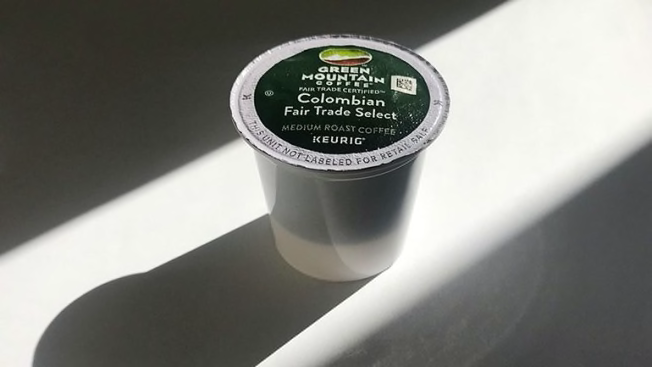
Photo: Lacey Browne/Consumer Reports Photo: Lacey Browne/Consumer Reports
“Polypropylene is accepted in a lot of curbside recycling programs,” says Dylan de Thomas, vice president of Public Policy and Government Affairs for the Recycling Partnership, a nonprofit that promotes recycling. But there aren’t many towns that accept No. 7 plastic. He says that’s because there just isn’t a robust market for those materials.
If you want to double-check that your pods are recyclable, check the bottom of the pod for a recycling symbol with the number 5. To recycle K-Cup pods, start by peeling off the aluminum foil top. Toss the aluminum top (its materials can’t be recycled when soiled), toss or compost the coffee grounds and the paper filter, and then rinse the plastic pod and add it to your recycling bin. Keurig has also rolled out several coffee pod blends that have an easy-peel lid that makes separating the foil top from the pod even easier.
Nescafé Dolce Gusto Pods
Nescafé pods are made of No. 1 and No. 5 plastics. If your town recycles both of these plastics, then you can recycle them yourself.
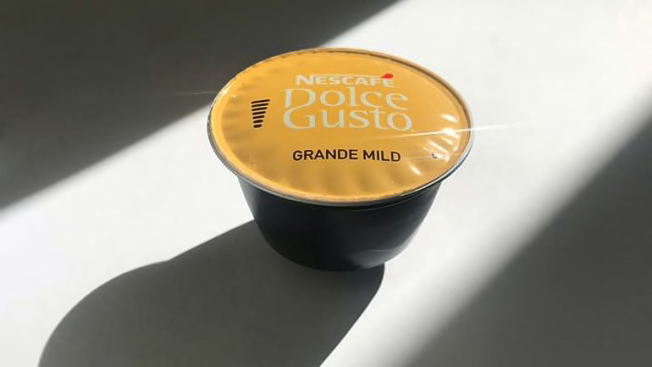
Photo: Lacey Browne/Consumer Reports Photo: Lacey Browne/Consumer Reports
First you’ll have to separate the individual components: two layers of plastic (including the lid), coffee grounds, a foil layer (which only lines the bottom of the pod), a plastic filter (right beneath the foil layer), and the plastic pod shell itself. You should be able to recycle the plastic filter and the pod shell. However, you might need to carefully use a sharp edge to separate the components, and you’ll need to rinse the filter and pod shell before putting them in your recycling.
A potentially easier alternative is to use Nestlé’s pod recycling program, which was created in partnership with TerraCycle. Contact Nestlé customer service for a TerraCycle recycling box with a prepaid shipping label, fill it with your used pods, and send it back.
Nespresso Coffee Capsules
Nespresso’s Original and Vertuo pods (which correspond to two different types of the company’s single-serve coffee machines) are made of aluminum, which is recyclable, but because of other materials in the pods, you can’t just throw them in your recycling bin.
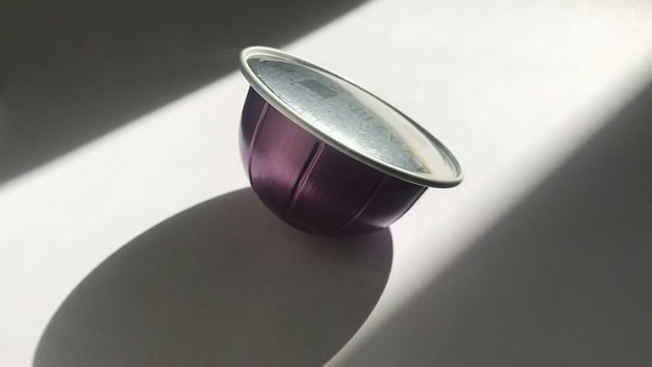
Photo: Lacey Browne/Consumer Reports Photo: Lacey Browne/Consumer Reports
The company encourages customers to use its own recycling channels. According to a Nespresso spokesperson, you have a few options: One, the company offers free pod-recycling bags (in stores and online) with prepaid UPS shipping labels. Those bags can be sent back to Nespresso from any UPS store or drop box.
Another option is to take used pods to any Nespresso Boutique or participating partner store, such as Sur La Table and Williams Sonoma. To find the closest recycling partner, use this Nespresso map tool.
Tassimo T-Discs
Tassimo T-Discs, used by lesser-known Bosch Tassimo brewers, are recyclable.
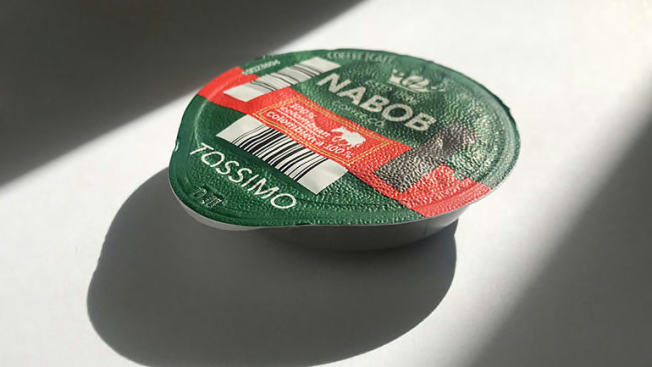
Photo: Lacey Browne/Consumer Reports Photo: Lacey Browne/Consumer Reports
According to Lynne Galia, a representative from Kraft Heinz—which makes Tassimo discs—the plastic T-Disc shell can be recycled after removing the foil top, filter, and coffee grounds, and rinsing it out. But like Nestlé, Tassimo also works with TerraCycle to make recycling easier: You can request a free envelope with a prepaid shipping label, put in your used pods, and drop off the package at a UPS location so your pods can be recycled.
Single-Serve Drip Machines Are a More Eco-Friendly Alternative
If you’re worried about the environmental impact of your pods, or if recycling seems like too much work, one thing you can do is switch to a reusable pod coffee filter. These are pod shells that you can fill with your own coffee grounds and use over and over.
But ultimately, the best way to minimize coffee pod waste is to ditch pod coffee makers altogether. “If you’re really concerned about the waste, you could switch to a single-serve drip coffee maker instead,” says Ginny Lui, who oversees CR’s coffee maker tests. Non-pod machines are better for the environment and better for your wallet since coffee pods tend to cost more per cup than pre-ground or whole-bean coffee.
You can find coffee makers that use regular coffee grounds to make one- or two-mug servings of coffee, and some make both single servings and full pots of drip coffee. Others are specifically designed to brew just a cup or two. Some take pods but also give you the option to use coffee grounds for single servings instead of pods. Here are just a few good candidates from our tests (ordered alphabetically).
You can also explore our full coffee maker ratings to find drip coffee makers, self-serve machines, grind-and-brew models, cold-brew makers, and more.
5 Things to Always Recycle
On the “Consumer 101” TV show, Consumer Reports reveals the five items you should always recycle rather than toss into the trash bin.





















